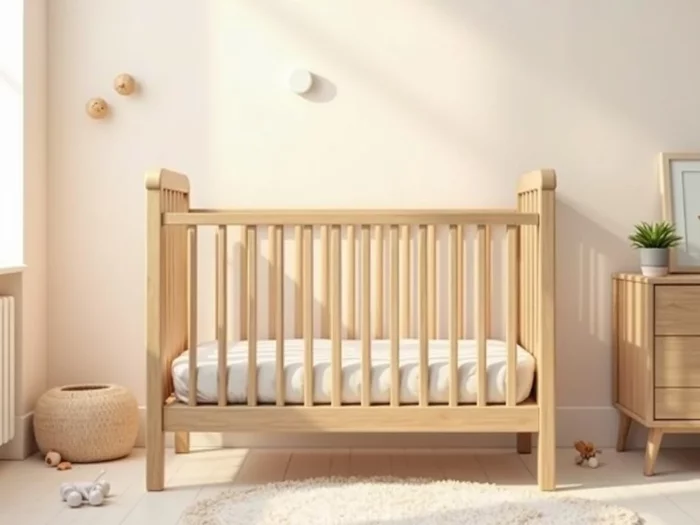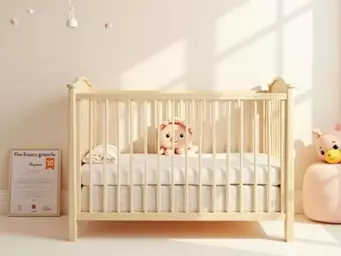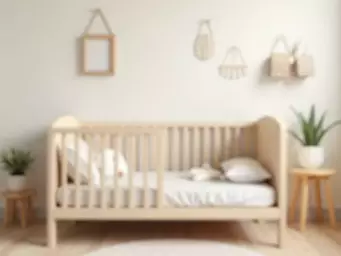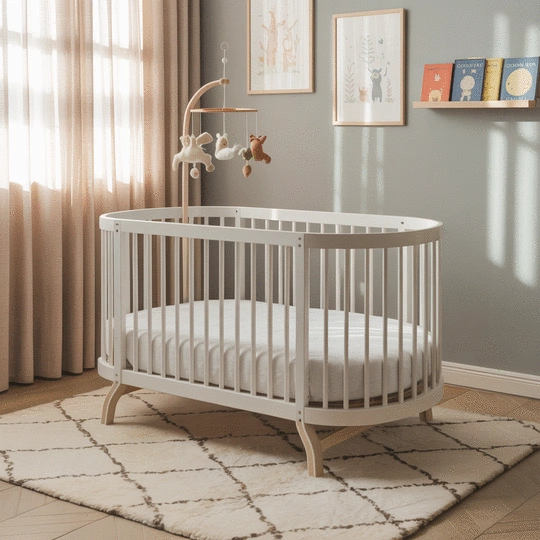Essential Baby Crib Safety Features

Posted on: 2025-11-04
By: Clara Jennings
In a world where safety means the utmost peace of mind for parents, being informed about crib safety standards is crucial. With various options available, how can you ensure the crib you choose is the safest for your little one?
What You Will Learn
- Understanding key UK safety regulations for baby cribs, including BS EN 716, BS 8509, and EN 16890.
- How to verify safety certifications from trusted organizations like JPMA and ASTM International.
- The importance of bar spacing and mattress fit to prevent potential hazards for your baby.
- Key physical features of cribs that enhance safety, such as construction quality and adjustable mattress heights.
- How to leverage reliable resources for researching crib safety and staying updated on standards.
Key Safety Aspects for Baby Cribs
Ensuring your baby's crib meets rigorous safety standards and features is crucial for a secure sleeping environment. Below is a breakdown of the key regulations and physical attributes to consider.
Bar Spacing Standard
Should not exceed 6.5 cm to prevent entrapment hazards.
Mattress Fit
Must fit snugly without gaps to prevent entrapment.
Construction Quality
Look for sturdy materials, non-slip bases, and secure latches.
Adjustable Heights
Allows mattress to be lowered as baby grows and stands.
Understanding Crib Safety Standards in the UK
When it comes to your little one's crib, understanding crib safety standards in the UK is absolutely essential. These guidelines are designed to ensure that every nursery is a safe haven for babies to sleep peacefully. Compliance with British safety standards like BS EN 716, BS 8509, and EN 16890 helps parents navigate the often overwhelming landscape of baby products.
These standards focus on various aspects such as the materials used, construction quality, and the overall safety features of the cribs on the market. So, as you explore your options, remember that adhering to these regulations is not just about legality; it's about the safety and well-being of your precious child!
Key UK Safety Regulations for Baby Cribs
- BS EN 716: Covers the safety requirements for folding cribs, ensuring they are secure and stable.
- BS 8509: Focuses on the safety standards for cot beds, emphasizing durability and safe usage.
- EN 16890: Addresses the safety requirements for cribs, including aspects like paint and finishes to ensure they are non-toxic.
Familiarizing yourself with these regulations can help you make an informed decision. As a passionate parenting expert at Baby Cot Beds, I can assure you that selecting cribs that meet these standards is a vital step toward creating a safe nursery environment.
How to Verify Safety Certifications
Once you've identified the relevant safety standards, it’s crucial to know how to verify compliance certifications on cribs. Look for endorsements from trusted organizations such as JPMA (Juvenile Products Manufacturers Association) and ASTM International. These certifications indicate that the products have undergone rigorous safety testing.
- Check for the manufacturer's documentation or labels that display the safety certifications.
- Visit the manufacturer's website for detailed information about the crib's compliance.
- Consult trusted resources and reviews to ensure the product's credibility.
By taking these steps, you can ensure that the crib you choose for your baby is not only stylish and functional but also adheres to the utmost safety standards. Let's prioritize safety together and create a cozy, safe space for our little ones!
Crucial Physical Features for a Safe Baby Crib
While safety standards are foundational, it’s equally important to consider the physical features of a crib that contribute to its overall safety. Not all cribs are created equal, and certain design elements can significantly enhance safety and functionality. I always recommend focusing on these critical features when selecting the perfect crib for your nursery.
Assessing Bar Spacing and Mattress Fit
Bar spacing is one of the most critical factors to consider. The UK standard stipulates that bar spacing should not exceed 6.5 cm. This ensures that your baby cannot get their head or limbs stuck between the bars, which is a common hazard. Additionally, ensuring a proper fit for the mattress is vital. A mattress that fits snugly without gaps helps prevent any potential entrapment hazards.
- Measure the crib's interior dimensions to find a mattress that fits perfectly.
- Check the manufacturer’s specifications to ensure the mattress size is compatible.
- Ensure that the mattress is firm and flat, which is essential for safe sleep.
By taking these precautions, you can significantly enhance your baby's safety during nap times and nighttime sleep. Your peace of mind is just as important as the comfort of your little one!
Evaluating Construction Quality and Adjustability
The construction quality of a crib is paramount. Look for cribs made from sturdy materials that can withstand the test of time and energetic little ones! Features such as adjustable mattress heights can also be incredibly beneficial, allowing you to lower the mattress as your baby grows and starts to stand.
- Choose cribs with non-slip bases to prevent them from moving around.
- Examine safety latches to ensure they function properly and keep the crib secure.
- Consider cribs with a solid frame that can support the weight of your baby comfortably.
By focusing on these aspects, you’re taking proactive steps towards creating a safe sleeping environment for your baby. Remember, a well-constructed crib not only enhances safety but can also provide long-term usability!
Pro Tip
When shopping for a crib, always check for additional features like adjustable mattress heights. This not only enhances safety as your baby grows but also makes it easier for you to place and lift your child from the crib. A crib that adapts to your baby's development is a worthwhile investment!
Frequently Asked Questions About Crib Safety
- What are the main UK safety regulations for baby cribs?
- The primary UK safety regulations include BS EN 716 for folding cribs, BS 8509 for cot beds, and EN 16890 for cribs, which covers aspects like non-toxic paints and finishes. Adhering to these standards ensures the crib is safe and durable.
- How can I verify a crib's safety certifications?
- You can verify safety certifications by looking for labels or documentation from recognized organizations like JPMA and ASTM International. Additionally, check the manufacturer's website and consult trusted consumer reviews for credibility.
- What is the importance of bar spacing in a crib?
- Bar spacing is critical to prevent entrapment hazards. UK standards stipulate that bar spacing should not exceed 6.5 cm (approximately 2.375 inches) to ensure a baby's head or limbs cannot get stuck between the bars.
- Why is a snug mattress fit crucial for crib safety?
- A snug mattress fit is vital to prevent gaps between the mattress and the crib sides. These gaps can pose entrapment risks, where a baby could get stuck, leading to potential injury or suffocation. The mattress should be firm and flat.
- What physical features should I look for to ensure crib safety and quality?
- Key physical features include sturdy construction from durable materials, non-slip bases to prevent movement, secure safety latches, and adjustable mattress heights. Adjustable heights allow you to lower the mattress as your baby grows, enhancing safety and ease of use.
Recap of Essential Safety Features for Baby Cribs
When it comes to choosing a baby crib, safety is our top priority, and understanding the essential features is vital for every parent. Throughout this article, we’ve discussed various safety features that ensure a secure sleeping environment for your little one. From compliance with British safety standards like BS EN 716 and BS 8509 to the importance of proper setup, each component plays a crucial role in your baby's safety.
To recap, here are the key safety features we covered:
- Compliance with safety standards: Ensure your crib meets UK regulations.
- Bar spacing: Maintain appropriate spacing (≤6.5 cm) to prevent entrapment.
- Mattress fit: Ensure a snug fit to avoid gaps that could be hazardous.
- Sturdy construction: Look for durable materials and safety features.
- Adjustable mattress heights: This allows for ease of access and safety as your baby grows.
By keeping these safety features in mind, you can make an informed choice that will help your baby sleep soundly and securely.
Encouraging Parents to Make Informed Choices
As a passionate parenting expert, I can't stress enough the importance of research when it comes to crib safety. With so many options available, it can be overwhelming to navigate the choices. That's why I recommend using credible resources like the NHS, Lullaby Trust, and the UK Baby Products Association to guide your decisions. These organizations offer valuable information that parents can trust!
Thorough research empowers parents to make informed choices about their baby's sleeping environment. Here are some benefits of using reliable resources:
- Access to up-to-date safety standards: Stay informed about the latest regulations.
- Expert recommendations: Gain insights from professionals in the field.
- Product recalls and safety alerts: Stay aware of any potential issues with baby products.
By leveraging these resources, you can feel confident that you're choosing a crib that prioritizes your baby's safety and comfort.
Call to Action: Download Our Safety Checklist
To help ensure you cover all essential safety features when selecting a crib, I've created a printable crib safety checklist just for you! This handy resource will guide you through the key aspects of crib safety, from setup to maintenance. Don't leave anything to chance—download your checklist today and make crib safety a priority for your little one!
Recap of Key Points
Here is a quick recap of the important points discussed in the article:
- Compliance with safety standards: Ensure your crib meets UK regulations such as BS EN 716, BS 8509, and EN 16890.
- Bar spacing: Maintain appropriate spacing (≤6.5 cm) to prevent entrapment hazards for your baby.
- Mattress fit: Ensure a snug fit to avoid gaps that could pose risks during sleep.
- Sturdy construction: Look for durable materials to enhance safety and longevity.
- Adjustable mattress heights: This feature allows for ease of access and safety as your baby grows.
 Did you know that starting in 2025, the UK will implement new fire safety regulations for baby cot b
Did you know that starting in 2025, the UK will implement new fire safety regulations for baby cot b
 Have you ever felt a mix of excitement and anxiety while choosing a cot bed for your baby? With so m
Have you ever felt a mix of excitement and anxiety while choosing a cot bed for your baby? With so m
 Choosing the right bassinet for your baby can be both exciting and overwhelming, especially when you
Choosing the right bassinet for your baby can be both exciting and overwhelming, especially when you
